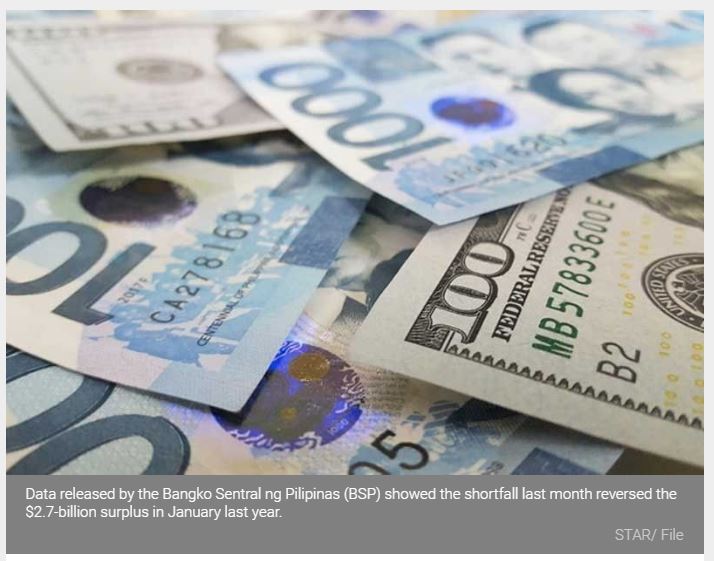Philippines: January BOP deficit highest in 16 months
MANILA, Philippines — The country’s balance of payments (BOP) position booked its widest deficit in 16 months, hitting $1.36 billion in January amid the strong outflows of foreign exchange as the national government settled more external obligations.
Data released by the Bangko Sentral ng Pilipinas (BSP) showed the shortfall last month reversed the $2.7-billion surplus in January last year.
The BOP gap in January was also the widest since the $2.69 billion shortfall recorded in September 2018. This also ended the streak at six months as the country has been posting BOP surpluses since July.
“The BOP deficit in January 2020 reflected mainly the outflows arising from the national government’s foreign currency withdrawals which were used largely to pay its foreign currency debt obligations as well as net outflows in foreign portfolio investments,” the BSP said.
The central bank said the outflows were partly offset by inflows representing the BSP’s net foreign exchange operations and income from its investments abroad.
The BOP is the difference in total values between payments into and out of the country over a given period.
A deficit means more foreign exchange flowed out to pay for the importation of more goods, services, and capital than what flowed in from exports, remittances from overseas Filipinos, business process outsourcing earnings and tourism receipts.
The central bank expects a BOP surplus of $3 billion or 0.7 percent of gross domestic product (GDP) this year.
The country’s external payments position remained robust as the BOP surplus hit a seven-year high of $7.84 billion last year, reversing the $2.31 billion deficit recorded in 2018. This was the highest since 2012 when the Philippines posted a surplus of $9.24 billion.
The amount was also higher than the $4.8 billion forecast by the BSP’s Monetary Board.
The BSP pointed out the BOP position reflects the final gross international reserves (GIR) level of $86.87 billion as of end-January, equivalent to 7.6 months’ worth of imports of goods and payments of services and primary income.
The buffer is also equivalent to 5.4 times the country’s short-term external debt based on original maturity and four times based on residual maturity
The BSP sees the country’s current account (CA) posting a deficit of $8.4 billion or 2.1 percent of GDP this year from the projected $5.6 billion or 1.5 percent of GDP last year.
The central bank expects strong foreign exchange inflows this year, with remittances growing by three percent, tourism receipts by 12 percent, business process outsourcing (BPO) revenues by five percent, and exports by four percent. On the other hand, imports growth is seen at eight percent.
Robert Dan Roces, economist at Security Bank, said the country’s BOP position is expected to record a surplus of $3 billion this year amid a wider CA deficit.
“For this year, we do expect imports to likely swell on the back of infrastructure spending, and this could lead to a renewed widening of the trade deficit since exports are also expected to contract after posting growth in 2019,” he said.
Roces added financial flows would be hard pressed to replicate its 2019 performance, translating to wider CA deficit and smaller financial account surplus amid the easing bias of the BSP as well as the relatively neutral stance by the US Federal Reserve.
“These should exert pressure on the BOP which we expect to be substantially smaller for the year compared with last year and probably in the $3-billion surplus territory,” Roces said.
Source: https://www.philstar.com/business/2020/02/21/1994764/january-bop-deficit-highest-16-months


 English
English




